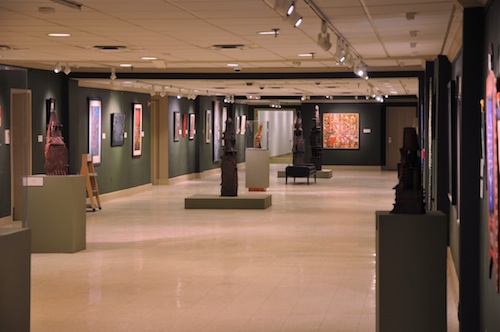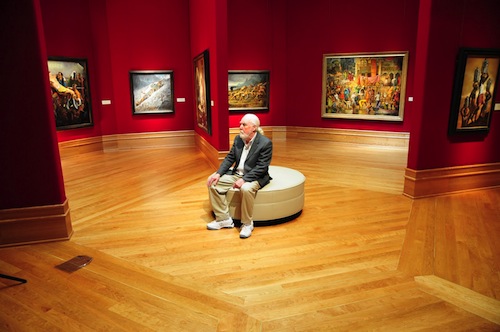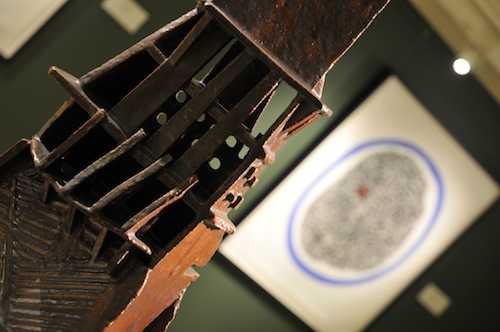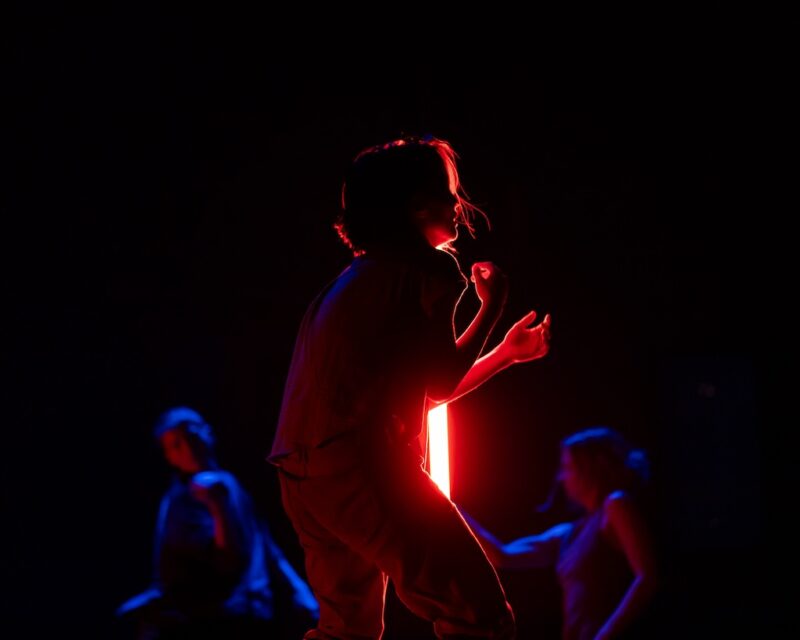If you are a Baltimore native and you’ve never heard of University of Maryland University College, or it’s art gallery, you are not alone. The college is fully accredited and part of the University System of Maryland. The school was designed for ‘adult students,’ which means commuters as opposed to campus dwellers, and offers virtual and traditional classes at the main campus in Adelphi, MD, as well as in Washington, DC, and a number of international locations.
In addition to its educational mission, UMUC has an art gallery with regular exhibitions by regional and internationally known artists, with the state’s largest permanent collection of work by Maryland artists, an impressive feat. The gallery features exhibits, lectures, receptions, and other events at a regular clip, with curator Brian Young at the helm. Young took some time away from his busy schedule to explain away some of the mystery surrounding his place of employment to Bmoreart’s readers.
CO: First of all, I have devoted close to ten years writing about contemporary art in Baltimore – How is it possible that I had never heard of the art gallery at UMUC until now?
BY: UMUC is sometimes in the shadow of larger organizations in D.C. and even College Park. However, we do enjoy some support from many with Baltimore ties such as Arts Advisory members Philip Koch and Myrtis Bedolla, and now myself, a Baltimore resident for a couple of years. In addition, we have great collections of many Baltimore artists including Joseph Sheppard, Gladys Goldstein, Raoul Middleman, Perna Krick, Ralph McGuire, and so on.
CO: What exactly IS UMUC???
BY: The “University of Maryland” portion signifies that we are part of the University System of Maryland. “University College” is an old British term which captures what we do: Take courses and programs from all academic departments and offer them outside of the university’s walls and normal class times. In 1947, UMUC broke away from College Park to focus on distance learning. Today, UMUC has the largest enrollment of any public university in the United States, serving more than 92,000 students at more than 150 locations worldwide and online.
CO: Can you give Bmoreart’s readers some general information about the art space and programs offered there? Where is it located? How large is it?
BY: As for the Arts Program, this has been referred to as UMUC’s football team. About 30 years ago, UMUC wanted to establish a tangible identity and to give our visitors a memorable experience while on campus. The Arts Program is located in Adelphi, Maryland, and is walking distance from the College Park campus. Our program consists of about 9 or 10 annual, temporary exhibitions in our Arts Program Gallery which is about 4,000 square feet. We also have the Leroy Merritt Center for the Art of Joseph Sheppard. Then there are galleries devoted to the work of Gladys Goldstein, Selma Oppenheimer, and Herman Maril. However, we also have a small, but strong collection of Chinese works across two millennia and significant collection of contemporary Japanese prints.
CO: What types of work do you show? What does your job as curator there entail?
BY: In addition to our permanent installations, we host temporary exhibitions, produce exhibition catalogs, host receptions, and organize symposia and artist talks. Our focus for our temporary shows is largely on artists from Maryland, Northern Virginia and Washington DC. In fact, this year, we will again host the BMRE, a juried biennial for artists from those areas. This prospectus will be issued in the next month or so.
That stated, we also do shows on a national and international scope. Currently, we have Diaspora, featuring the work of three African-born artists who then settled in the U.S. They are Victor Ekpuk (D.C.), Kwabena Ampofo-Anti (Hampden, Virginia) and Skunder Boghossian (New York City). Prior to that we did a show of the work of James Hilleary, a Washington Color School artist. Before that, Vista, an exhibition of contemporary Latin-American work.
CO: What are the opportunities for local artists, in terms of exhibiting there?
BY: In addition to the BMRE, I also curate an annual invitational for art professors in the state of Maryland. In general, any artist from Maryland, DC and NoVa is welcome to submit jpegs and links to me, [email protected] to be considered for a solo or group exhibition. Together, with Eric Key, the director, and our advisory board, we chart our course of exhibitions. Right now we are working on the end of 2014 and looking to 2015.
One of the most interesting things about the UMUC gallery is that it includes a permanent collection of national and regional artists. What is your responsibility as curator to the permanent collection? Who chooses what works to buy for it? What happens to works after they are purchased?
My responsibility to these different spaces is to put these artists and their long careers in the best possible light. In the case of Joseph Sheppard, we change out the exhibitions on a yearly basis. For the others, we refresh the spaces on occasion to keep our visitors interested.
As for purchases, we don’t have large sums to spend so we concentrate on potential donors. We try to locate those individuals who share our goal to concentrate on those artists from this region. Whether gifts or purchases, we try to rotate works in our public spaces. We put art in the buildings at Adelphi, Largo, and even once a year at the Federal Courthouse in Largo. We don’t acquire with the goal of stockpiling things in storage.
CO: How long have you been curator at this space? What did you do before?
BY: I am closing in on my second full year as the Curator for UMUC. Prior to that, I was the curator at three other museums: the Academy Art Museum in Easton, Maryland; Cranbrook Art Museum, outside Detroit; and the Arkansas Arts Center in Little Rock.
CO: What do you think of living in Baltimore?
BY: I love Baltimore! In fact, my wife attended Law School at UB. So, it has been actively on our radar for over four years. We both enjoy the thriving visual arts scene including the Walters, BMA, Historical Society, Baltimore Clayworks, and then the great programs at UMBC, Towson, Morgan State, and so on. And I am also on the advisory board for Maryland Art Place (MAP). Then there are the commercial spaces like Grimaldis, Goya Contemporary, Steven Scott, and so on.
I am also a big fan of other cultural spots. My wife and I have been to Orioles’ games, Hopkins Lacrosse, Woodberry Kitchen, the National Aquarium, the Peabody Library, and so on. We bought a house recently in Mt. Washington and hope to stick around.
For more information, go to the Gallery at UMUC’s website here.







